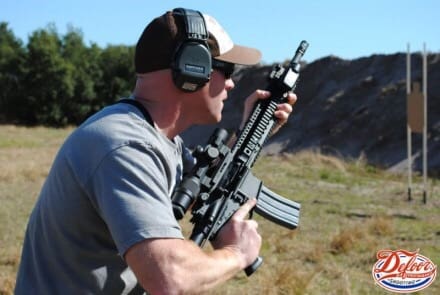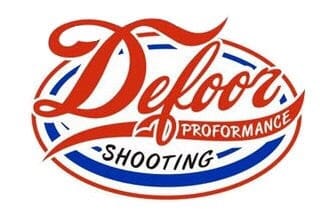In the last article I laid out my beliefs on the best optic for a mag fed carbine. Here, I’ll go over how we have gotten true one power scopes with daytime visible red dots to work as good as a traditional red dot up close with speed by mounting them the best way possible for your application. I’m going to break this down the three categories; height, type, and placement.
Height- how high you mount the scope off the top of the rail is important for a few reasons. First, if you are using a true one power scope with a daytime visible red dot you will need to make sure when you are on one power you don’t see anything in the bottom part of the reticle. This will adversely effect your short range shooting.
If you have a short barrel rifle out to about a 12 inch barrel you can generally get away with a 1.5 inch tall mount. If you have a 16 inch long barrel it’s very possible you will see part of your rail or flipped down front sight in the bottom part of the reticle on one power with a 1.5″ tall mount. There is a little bit of this that depends on the type of buttstock you are using and your overall face structure-whether you have a thin face or a more round face. The last factor would be where you like to position your butt stock, all the way out or somewhere in between?
Next, If you use any type of IR laser on the top rail this will also make a difference in whether the bottom part of your reticle has any image in it on one power. There are two solutions for this problem. One, is to use a higher mount. Typically somewhere around 1.9 to 2 inch height will give you a clear view over the top of any IR laser mounted on the top rail even with a 16″ barrel. The second option is to slide the IR laser closer to the objective lens of your scope. This may or may not work depending on the construction/type of the IR laser you have and barrel length. With my personal 11.5 inch barreled upper I can use a 1.5″ mount with a DBAL IR laser top mounted and have no issues with my USO 1-4 on one power. The second solution is to side mount your IR laser.
Mount types- I personally only use QD mounts simply because I never want to be in a position where I cannot use the gun because of some odd issue with the scope or my surroundings. I also always have zeroed irons on there ready to go. I’m a big fan of Bobro mounts because of the lever which takes away any movement in the rail slot. For non Q/D mounts I use Badger Ordnance. The type of mount you choose may depend on what mount height you need. As of this writing Larue is the only Q/D mount I’ve seen that will make a 1.9~2 inch tall mount. Do your research and make sure though.
Placement- The first thing you should know when mounting a scope to a rail is if there is any slack between the mount and the rail push as far forward toward the barrel before you lock down the mount. Recoil ends up forward and this will help in keeping your optics from shifting especially on higher calibers.
Secondly, and the real juice for this article is where to mount your LPV (low power varible). What I found to be the most beneficial it is to mount your scope a little bit forward of where it traditionally should be done. You can do this by moving the mount one, two or more slots forward in the rail or by moving the scope forward in the mount or a combo of both. I personally will put my scope on one power with the daytime visible red dot on and move it far enough forward that I do not have a traditional eye relief or sight picture that most people would call “good” for a scope. Another way to describe it is that my scope is mounted far enough forward that I actually do have a bit of scope shadow on one power. Although this may be counterintuitive to what most people have been taught or read this is the only possible way you can match the speed and target transition of a traditional RDS with an LPV. Keep in mind that when you are on one power with the red dot traditional fundamentals of scope shooting don’t apply. Also keep in mind how very little (.5-.75″) I am trying to describe with written word I push the scope forward to get the speed shooting benefit. Lastly, by doing this it will mean that when you are on max power (4,6 or 8) with your LPV you will need to slightly slide your face forward on the butt stock to get a fundamentally acceptable scoped sight picture for an accurate long range shot- but, because it is a long range shot you have time to do that.
Kyle Defoor is one of the world’s most committed and passionate shooting instructors. Literally growing up with a gun in hand he took his talents into the military where he was combat decorated as a SEAL assaulter and sniper. Kyle helped to create and define modern training while along the way personally teaching thousands of military personal and civilians from around the globe. His shooting prowess led to appearances on multiple TV shows including Shooting Gallery, Tactical Arms, and Tactical Impact, and guest appearances on History Channel. Kyle’s outdoor athletic lifestyle includes shooting, ultra running, stand-up paddle surfing and climbing. He is a sponsored athlete of MultiCam and runs his own company, Defoor Proformance Shooting, which offers tactical training, wilderness navigation, TV and film consulting, and motivational speaking.
Gunfighter Moment is a weekly feature brought to you by Bravo Company USA. Bravo Company is home of the Gunfighters, and each week they bring us a different trainer to offer some words of wisdom.
Tags: Kyle Defoor




Good recommendations…however, with a recommended caveat. When it comes to positioning Lasers (LA-5, any of the PEQ series – 15/15A1 – PEQ-16, and now MAWL – although not as much an issue) be very cognizant how far back toward your sight your laser system is on the rail, for two reasons:
1) laser shielding/splash back – this is very easy to cause if you are not careful and can lead to divergence/masking issues and in the case of small unit tactic (maneuver) false ID problems. You can easily mask on your hand when emitting causing friendlies adjacent or slightly off maneuver line to mis-ID the splash. By this I mean, you’ll have to be very aware of you’re hand placement so that it doesn’t interrupt the laser emission.
2) bullet trajectory/ordinate – the further back toward your sight you position your laser, can now effect the lasers relationship to the bullet trajectory/ordinate. The same effect can happen by mounting the laser if its mounted on the left side at 9 o’clock where the laser pointer is essentially underneath the barrel.
These are just considerations to take into account and not meant to contradict the post in any way.
In any event, I just offer a suggestion to take into consideration to expand on the post and to start the conversation…
Informative and well written article, Kyle. Very good supplementary post, Jose.
A lot of experience here.
Professionally delivered details by both of you without the aid of photos or videos. Well done.
Dave
When Jose and Dave chime in, all posts are better off.
I’ve never found a proper eye relief to slow me down, but I will have to try Kyle’s idea about setting the scope slightly further forward and see if it helps me.
When i saw that KD had posted a gunfighter moment, it literally made my day..
Yup, more KD is never a bad thing.
I’m interested to see if LBV really will dominate the market in a few years, they do seem to be gaining adherents.